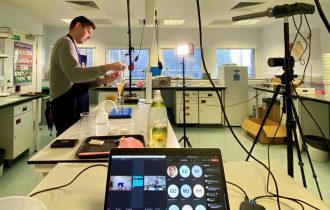Designing Engaging Curriculum for Hybrid Learning
As our education system continues to evolve, the challenge educators face is to design curriculum that leverages the benefits of hybrid learning – a model that effectively blends traditional in-person instruction and online learning. A well-designed curriculum can significantly boost engagement, facilitate better understanding, and ultimately lead to higher academic success.
“The principal goal of education is to create individuals who are capable of doing new things, not simply repeating what other generations have done.” – Jean Piaget, renowned developmental psychologist.
1. Understanding the Principles of Curriculum Design for Hybrid Learning
Designing a curriculum for hybrid learning requires a departure from traditional methods. Here are some guiding principles:
Student-Centered Learning: The curriculum should empower students to take ownership of their learning, encouraging them to explore subjects at their own pace and in their preferred learning style.
Flexibility: The curriculum should provide flexibility in terms of when and where learning takes place.
Integration: The curriculum should seamlessly integrate face-to-face and online components, ensuring that they complement and enhance each other.
Active Learning: The curriculum should encourage active engagement, promoting critical thinking, problem-solving, and collaboration among students.
2. Embracing Innovative Technologies
Incorporating technology in curriculum design is a key component of hybrid learning. Here are some tools and strategies that can be used:
Learning Management Systems (LMS): These platforms provide a central location for course materials, assignments, and discussions. Examples include Canvas, Blackboard, and Google Classroom.
Digital Tools for Collaboration: Tools like Google Docs, Slack, and Microsoft Teams can foster collaborative learning.
Interactive Learning Tools: Tools like Kahoot!, Quizlet, and Nearpod can create engaging and interactive learning experiences.
AI and Adaptive Learning Technologies: These technologies can tailor learning to individual student needs, promoting a personalized learning journey.
The ASU Prep Digital program is a successful example of technology integration in hybrid learning. They utilize Canvas as their primary LMS, and integrate various digital tools for collaboration and interactive learning. With the addition of adaptive learning technologies, the program delivers a personalized, engaging, and effective learning experience for their students.
3. Crafting Engaging Learning Activities
Creating engaging learning activities is essential to stimulate interest and promote active learning. Some strategies include:
Flipped Classroom: In this model, students consume lecture materials online at their own pace and use in-person class time for discussion, problem-solving, or hands-on activities.
Problem-Based Learning (PBL): This method involves students working on real-world problems, developing critical thinking and problem-solving skills.
Peer Learning: Encouraging students to teach and learn from each other can foster a sense of community and deepen understanding.
Project-Based Learning: This method involves working on real-world projects, promoting critical thinking, problem-solving, and collaboration.
Stanford University’s Bioengineering department effectively employs these strategies. They implemented a flipped classroom model where students watch lectures online before engaging in problem-solving sessions in class. They also use problem-based learning and project-based learning methodologies, fostering active engagement and deep understanding.
4. Facilitating Effective Assessment and Feedback
Assessment and feedback are critical components of an engaging curriculum, providing students with a sense of progress and areas for improvement.
Formative Assessments: Regular formative assessments can provide ongoing feedback, helping students understand their strengths and areas for improvement.
Peer Feedback: Peer reviews can offer students a different perspective and promote a sense of community.
Self-Assessment: Encouraging students to assess their own work fosters a sense of ownership and promotes self-reflection and self-improvement.
Automated Feedback: Utilizing AI technologies for automated feedback can provide personalized and immediate responses, enhancing the learning experience.
The University of Maryland implemented a comprehensive assessment and feedback system in their hybrid learning model. Regular formative assessments, peer feedback, self-assessments, and automated feedback through AI technologies are all part of their curriculum, offering students varied and meaningful feedback.
In conclusion, as education visionary Sir Ken Robinson aptly stated, “Curriculum is a narrative about the future.” A well-designed curriculum for hybrid learning should be student-centered, flexible, integrated, and engaging. It should leverage the power of innovative technology, create engaging learning activities, and provide effective assessment and feedback mechanisms. These components not only drive student engagement but also shape a future of lifelong learners.



